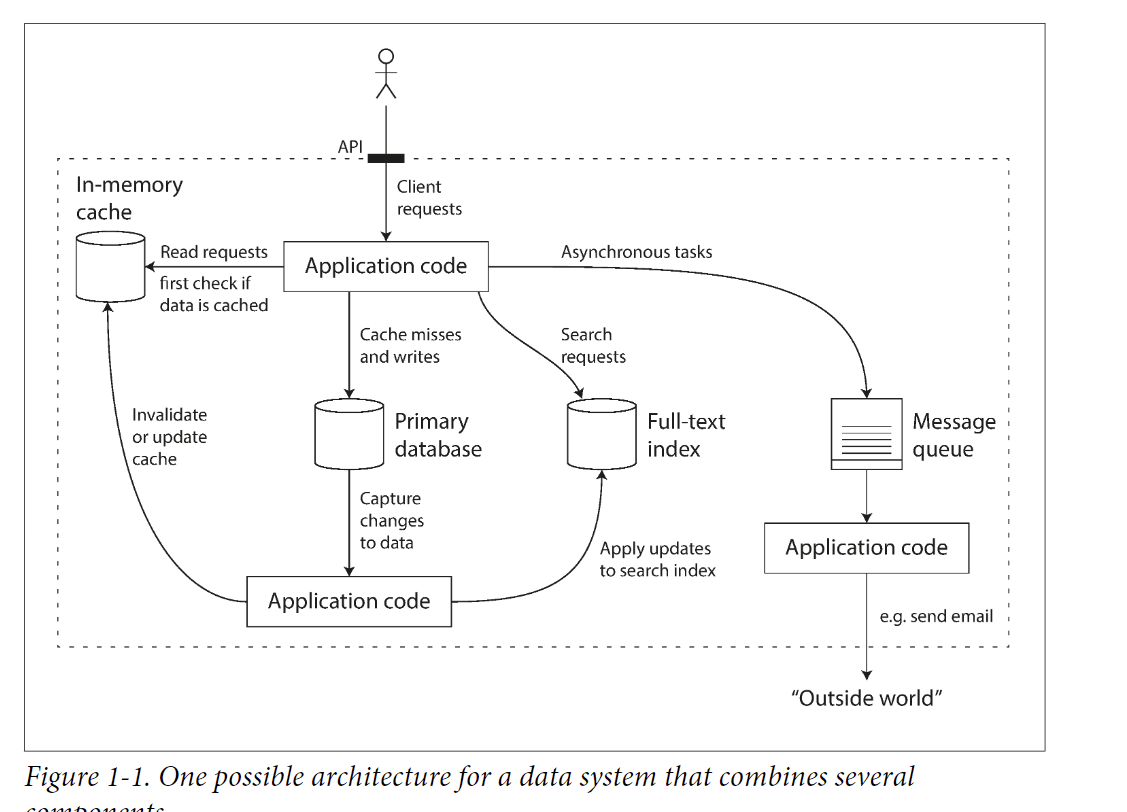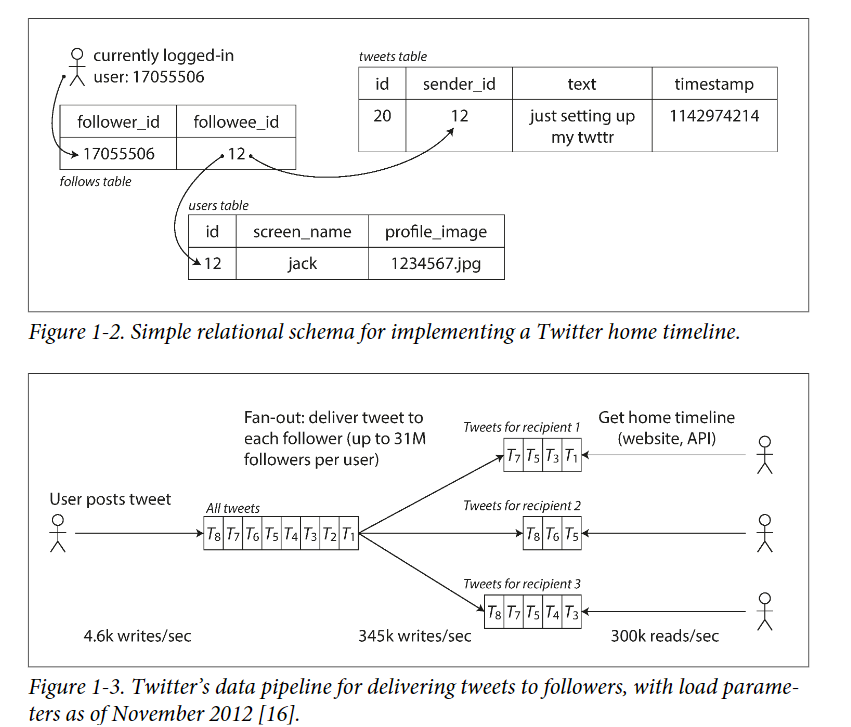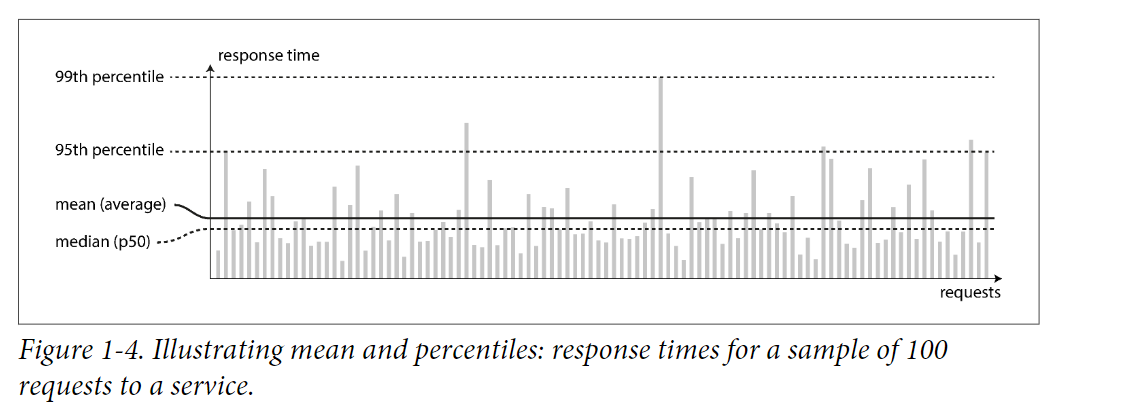Ch1 Reliable, Scalable, and Maintainable Applications
Introduction
- Data-intensive v.s compute intensive
- Most application are data-intensive, cpu power is not a limiting factor
- Most problems: amount of data, complexity of data.
- Supplementary:
- Single-threaded web server (NodeJS) v.s. multi-threaded web server (Golang)
Standard building block of an application
- Store data persistently. (Database)
- Remember result of expensive operation. (Cache)
- Search data by keywords. (Search indexes)
- Ingesting a continuous data stream to quickly analyze, filter, transform or enhance the data in real time(Stream processing)
- Periodically process large amount of data (Batch processing)
About these building blocks
- These data system are successful abstraction.
- E.g. Developer doesn’t need to write a new database from scratch.
- Same category of data system may have many different characteristics
- E.g. Many different implementation of Database, Various approach to caching.
- Figure out which tools and which approaches are the most appropriate for our app.
Thinking About data systems
- The traditional categories becomes blur
- E.g. Redis can be a datastore, and also used as message queues.
- A single tool can no longer meet all needs.
E.g. Cache, full-text search, and database
It’s the application’s responsibility to sync data within these componenets.
- Now, you’re both an application developer and a data system designer.
- How to ensure the whole data system work correctly?
- E.g.
- How to ensure data remain correct and complete when something go wrong?
- How to provide consistently good performance to clients when some part of system degrade?
- How to scale when increase in load?
- Focus on three important concerns in most software systems
- Reliability
- System continue to work correctly even when fault occurs.
- Fault included: Hardware, software faults, human error.
- System continue to work correctly even when fault occurs.
- Scalability
- Ways to handle when the system grows in data or traffic volume.
- Maintainability
- People should be able to work on it productively.
- Reliability
- E.g.
Reliability
- Roughly meaning: “Continuing to work correctly, even when things go wrong”
- faults:
- One component of the system deviating from its spec.
- c.f. failures: The whole system stop providing service.
- System that anticipate faults and can cope with them are call fault-tolerant or resilient
- How to test a system is fault-tolerant?
- Deliberately generate faults.
- E.g. Netflix Chaos Monkey: randomly kill instance and see whether service works fine.
Hardware Faults
Examples:
- Hard disk crash, power blackout, someone unplug network cable, etc.
- Hard disk’s Mean time to Failure (MTTF)
- 10~50 year.
- First solution: Add redundancy in component
- Set up disk in a RAID configuration.
- Dual power supplies for server.
- Idea: When one component die, the redundant component can take its place.
- Result:
- Make total failure of a single machine rare.
- Multi-machine redundant is not necessary.
- Trends:
- As data volume and application’s computing increased, more app use larger number of machines.
- It’s common that vm provided with cloud provider become unavailable without warning.
- Platform is designed to prioritize flexibility and elastic over single-machinie reliability.
- Second solution: Using software fault-tolerance technique in preference
- System should tolerate the single-machine shutdown.
- Advantages:
- Can perform rolling upgrade:
- Reboot a machine to security patch, one node at a time, while other machine can still maintain the service without downtime.
- Can perform rolling upgrade:
Software Faults
- Hardware faults are random and independent.
- Software faults(Systematic faults) are harder to anticipate, and may have relation between faults.
- Examples:
- Given a bad input cause the whole system crash
- A process that exhaust all CPU, memory resource.
- Solutions:
- Carefully thinking about assumption and interaction in the system.
Human errors (similar to software faults)
How to build reliable system without human errors:
- Design system that minimize opportunities of errors
- E.g. Well-designed abstraction
- Testing
- From unit test to end-to-end test, use automated test.
- Allow quick and easy recovery from human errors
- Fast to rollback and gradually roll out new code.
- Set up detailed monitoring and alerting.
Scalability
Describing Load
Succintly describe current load of system.
- Load can be described with a few number called load parameters.
- Load parameters including:
- rps, r/w ratios, cache hit rate, etc.
- Observe the average and extreme cases.
- Example: Tweet
- Two API
- User post tweet
- Browse home timeline (should see the followees’ posts)
- Two different ways to handle
- Method 1
- User post tweet: Directly write into database. (fast)
- Browse Timeline: Perform join on database for all followees’ post. (slow)
- Method 2
- User post tweet: Write post to all follower’s individual cache. (slow, many write)
- Browse Timeline: Directly fetch from cache. (fast)
- Method 1
- Two API

- Initially, Twitter use method 1, but system load home timeline slowly.
- We can found that home timeline query is more frequent than post tweet.
- Hence, it consider method 2.
- For method 2, posting tweet may cost lots of time.
- Firstly, we observe the average followers of each user is 75. So the write cost should * 75.
- However, we omit the fact that some celebrity have extreme high followers(30 million), which can cause high write suddenly.
- For twitter, the distribution of followers per user is the key load parameter.
- Finally, twitter use a hybrid approach.
- For normal user, use method 2.
- For specific celebrity, use method 1.
- When browsing timeline, merge the local cache and the join result from db.
- Ref: https://github.com/donnemartin/system-design-primer/blob/master/solutions/system_design/twitter/README.md
Describing performance
In online system, service’s response time is more important to describe performance.
- Response time: The time between client send request and receive response.
- Every try may have different response time.
- Measure as distribution.

- We should take care of outliers seriously.
- Perhaps the slowest request is from a more valuable customer because they usually have more data to load.
- Use percentile instead of average to tell how many customer actually experienced delay easily.
- E.g. p50: median percentile, p90, p99
- Amazon describe performance in terms of p99.9.
- Head-of-line blocking
- Server is blocked at a slow request and can’t handle subsequent request.
- Even if subsequent request is fast to process, client still feel high response time.
- Tail-latency amplification
When an incoming request need to call other backend services, the slowest request is the bottleneck.
The probability for client to meet slow request is higher.

Approachs for coping with load
- Scale up (vertical scaling)
- Scale out (horizontal scaling)
- Scale out is cheaper than scale up.
- Elastic
- Automatic scaling by observing some metric.
- Stateless v.s. Stateful
- Stateful: Take Stateful data system from one node to a distributed setup introduce lots of complexity.
- Stateless: Share-nothing architecture.
- Distribute load across multiple machine. (stateless)
- There is no one-size fit all scalable architecture
- Scaling is highly specific to application.
- Different problem. E.g. r/w volume, data volume, etc.
- Determine which operations are common and which operations are rare.
- Decide important load parameter.
Maintainbility
- Majority cost of software is the ongoing maintenance.
- E.g. fix bugs, keep system operational, investigating failures, pay tech debt, etc.
- We should design software in a way that minimize pain during maintenance and avoid legacy software ourselves.
- Three design principles for softwrae systems:
- Operability
- Make it easy for Op teams to keep system running.
- Simplicity
- Make it easy for new engineer to understand the system by removing complexity.
- Evolvability
- Make it easy for engineer to make changes to the system in the future.
- A.k.a extensibility, modifiability, plasticity.
- Operability
Operability
Operation teams are vital to keeping a software running smoothly.
Responsibility:
- Monitoring the health of system, and quickly restoring service if it’s shutdown.
- Tracking down the cause of problem.
- Logging
- Keeping softeware and platforms up to date, including security patches.
- Establishing good practice and tools for deployment, configuration management and more.
- Good operability means making routine tasks easy.
- Data systems can do various things to make routine tasks easy:
- Visibility into the runtime behavior of the system
- Good support for automation and integration with tools.
- Provide Documentation.
- Rolling upgrade
- Self-healing
Simplicity: Manage complexity
- Possible symptons of complexity:
- Extra state space
- Tight coupling of modules
- Tangled dependency (cyclic dependency ?)
- inconsistent naming.
- Special-case to workaround issue.
- Complexity system drawbacks
- Greater risk of introducing bug when making a change because
- system is harder to understand
- hidden assumption
- Greater risk of introducing bug when making a change because
- Tools for remove unnecessary complexity: Abstraction
- Hide implementation detail behind a clean, understandable interface.
- easy to use for other applications.
- E.g. SQL is an abstraction that hide complex on-disk and in-memory data structure, concurrent requests from other clients (Still need to consider), and inconsistent after crash.
Evolability: Make change easy
- Agile development: Adpating to change easily.
- TDD (Test-driven design)
- Refactoring.
Summary
- Reliability
- System continue to work correctly even when fault occurs.
- Fault included: Hardware, software faults, human error.
- System continue to work correctly even when fault occurs.
- Scalability
- Ways to handle when the system grows in data or traffic volume.
- Maintainability
- People should be able to work on it productively.